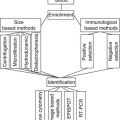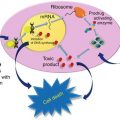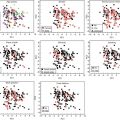BRCA 1
CD105
BRCA 2
Survivin
HER2 gene (HER2/neu or ErbB2)
COX-2
MYC
Ki67
ER
Tropomyosins
PR
NAT1
BRST2
RAD51B (14q24.1)
AR
TOX3 (16q12.1)
C-erb-2
rs13387042 (2q35)
p53
rs10941679 (5p12)
p16
rs9383938 (6q25.1)
p21
rs2981579 (FGFR2)
P21/Waf1
rs3803662 (TOX3)
p27Kip1
rs6504950 (COX11)
ESR1
CCND1 (11q13)
PGR
TRAF4 (17q11)
PPM1D
CDC6 (17q21)
ZNF217
MTDH (8q22)
CCND1
Tropomyosin-1
KRAS,
Cathepsin D
MMP2 and MMP9
Galectin-1
HFE
Enolase1
MSH2
MSH6
MLH1
CDH13
PMS1
PAX5
PMS2
PAX6
Cyclin D1
WT1
EGFR
GATA5
Bcl 2
GSTP1
PCNA
HOXD10
Apolipoprotein D
VEGF
MBTAA
HSP27
CHEK2 (Li-Fraumeni syndrome)
PDI
PTEN (Cowden syndrome)
PPIA
PARP
Prx1
CK 5/6, 8, 18, 19 and 14
MicroRNAs
CYP17A1 and CYP19A1
Hypermethylation
CD31 and CD34
Due to genetic diversity in MBC, and the paucity of specific markers and standardized treatment modalities, novel diagnostic and therapeutic approaches should continue to be developed. Omics and related technologies should become crucial at this point.
Omics and Related Subterms
With this neologism, a set of terms with -omics suffix are implied in fact. The best known samples include genomics, proteomics, and metabolomics. Omics aims to reveal a holistic approach to genome and proteomes [53]. According to Merriam-Webster, the medical definition of genomics is “a branch of biotechnology concerned with applying the techniques of genetics and molecular biology to the genetic mapping and DNA sequencing of sets of genes or the complete genomes of selected organisms using high-speed methods, with organizing the results in databases, and with applications of the data (as in medicine or biology).” The medical definition of proteomics is “a branch of biotechnology concerned with applying the techniques of molecular biology, biochemistry, and genetics to analyzing the structure, function, and interactions of the proteins produced by the genes of a particular cell, tissue, or organism, with organizing the information in databases and with applications of the data (as in medicine or biology)” [54].
Genetic sequences and even fully genetic blueprints can regrettably give, to a certain extent, information about the functional and dynamic processes related to physiological and pathological situations. Therefore, the need for genetic studies intensely remains, even though the Human Genome Project (HGP), completed in 2003, tried to reveal identifying all genes up to 22,000 in human DNA, determining the sequences of the three billion base pairs in human DNA, and storing and improving all this data [55]. Thus, no information about genetic productivity, functionality, and final protein metabolism can be obtained by looking at a genetic sequence. For especially polygenic diseases and conditions such as aging, diabetes mellitus, cardiovascular disorders, and cancer, more functional and global approaches should be developed. Thereupon following HGP, we have entered into the postgenomic age, in which functional studies rather than structural ones and dynamic studies rather than static ones will gain importance (Table 13.2).
Table 13.2
Omics progress
Genomic age | Postgenomic age | ||
|---|---|---|---|
Terms | Gen | → | Genomics |
mRNA | → | Transcriptomics | |
Protein | → | Proteomics | |
Analyses | Structural | → | Functional |
Static | → | Dynamic | |
Individual | → | Global |
Indeed, proteomics make a global description of proteins possible, yielding the new useful markers like oncomine platform in more accurate diagnosis and exact prognostic designation of certain important diseases such as malignancies [30, 56, 57]. Proteomics is also useful to reveal postgenomic events, which play important roles in tumoral phenotype [57]. Tumoral behavior will be understood much better by advanced mass spectrometry and proteomics studies.
Omics and Male Breast Cancer
Unlike female breast cancer, the prevalence of protein alterations in MBC is scarcely known [58, 59]. The proteomics studies can lead to exploring original modalities of this disease from diagnosis and treatment to prognosis [58].
It is supposed that breast cancer is a very different disease between genders. This difference can result from a particular genetic background and thereby lead to different clinical approaches modified as to this fact [59]. Indeed, genetic identification is very important in revealing gene function and so in improving medical treatment [60].
Barh and Das investigated sophisticated interactions among 25 genes involved in MBC pathogenesis by using a broad bioinformatics approach [38]. These genes were BRCA1, BRCA2, HER-2/ERBB2, P21/Waf1, P53, MYC, AR, CYP19A1, ESR1, PGR, PPM1D, ZNF217, CCND1, KRAS, CHEK2, MMP2, MMP9, CYP17A1, PCNA, PTEN, HFE, MSH2, MLH1, PMS1, and PMS2 [38]. In this study, the authors found that these genes were involved in ER and EGFR signaling, in addition to DNA repair pathways in MBC pathogenesis [38]. MYC genes found as downstream target of the pathways were regulated by TNF, EGF, TGF, and estrogen through ERBB2, and estrogen was the major regulator of these MBC pathways [38]. Additionally, any abnormal AR expression had to affect all three critical pathways according to their key node analysis [38]. With their results, the authors claimed that a pharmacogenomics approach will be more effective than conventional treatment modalities due to the broad genetic variability among MBC patients [38]. Chemopreventive dietary and some phytochemicals targeted on the individual genetic event, such as inducing apoptosis or arresting tumoral proliferation which has not had adverse effect on normal cells, can be safer treatment options [38]. Within this framework, the authors stated that some phytochemicals including resveratrol, indole-3-carbinol, glyceollins, genistein, lycopene, tangeretin, EGCG, curcumin, sulforaphane, retinoic acid, beta-carotene, grape seed extract, and dibenzoylmethane are effective on some key molecules such as ESR1, BRCA1, BRCA2, PTEN, beta-catenin, aromatase (estrogen), VEGF, TGF, MMP-2, MMP-9, NF-kappaB, AKT, EGFR, PKC, and HER2 to inhibit tumoral growth. Furthermore, in this interesting report, it was suggested that curcumin, resveratrol, ATRA, genistein, and EGCG could be used in all MBC types irrespective of their molecular profile because these five phytochemicals covered and targeted all genetic pathways, which makes them promising potential cancer drugs used singly or in combination with acceptable adverse effects [38].
In their report, Orr et al. performed a genome-wide association study (GWAS) of MBC and control cases and found that a single-nucleotide polymorphism (SNP) in RAD51B at 14q24.1 was significantly associated with male breast cancer risk (odds ratio (OR) = 1.57) and clarified an association at 16q12.1 to an SNP within TOX3 as well (OR = 1.50) [61].
In another GWAS by Orr et al., SNPs showing a statistically significant association with MBC were rs13387042 (2q35) (OR = 1.30), rs10941679 (5p12) (OR = 1.26), rs9383938 (6q25.1) (OR = 1.39), rs2981579 (FGFR2) (OR = 1.18), and rs3803662 (TOX3) (OR = 1.48). They found that OR values between male and female breast cancer were different in terms of the following SNPs: rs13387042 (2q35), rs3803662 (TOX3), and rs6504950 (COX11), which points out the heterogenic nature of the disease and difference between genders [25]. These and similar studies strongly show the importance of GWAS in identification of renewed risk loci in MBC, which represents new perspectives on the molecular background of this malignancy [25].
Using multiplex ligation-dependent probe amplification (MLPA), copy number gain of the genes CCND1 (11q13), TRAF4 (17q11), CDC6 (17q21), and MTDH (8q22) was found as important in MBC carcinogenesis and as higher than 40 % in male breast cancer. Copy number gain of one or more genes was related to highly malignant phenotype [62]. In this study of Kornegoor et al., independent prognostic parameter, namely, the most important single gene in prognosis, was CCND1 amplification in MBC [62].
Matrix-assisted laser desorption/ionization time of flight (MALDI-TOF) mass spectrometry can be used in the determination of differential protein expression, leading to new biomarkers in malignancies [16]. Underexpression of tropomyosin-1, a tumor suppressor, and alterations of cathepsin D and galectin-1, mediators of cellular invasion, and metastasis were reported [16]. Also, using comparative genomic hybridization (CGH), gains were most frequently observed at 1q, 8q, and 16p, and losses were most frequently observed at 8p, 16q, and 13q [63].
Hypermethylation is an important epigenetic change accompanied by genetic events. Promoter hypermethylation, which is a notable gene-silencing mechanism, may be an earlier event in cancer development [64]. The reversible nature of this mechanism makes it a suitable therapeutic target and useful marker in monitoring the response to treatment and prognosis [64]. Indeed, methylation can play physiological roles in genomic imprinting and many malignant processes [64]. Kornegoor et al. studied methylation of some tumor suppressor genes in MBC by using the methylation-specific multiplex ligation-dependent probe amplification (MS-MLPA) [64]. In their study, in more than 50 % of tumoral samples, there was promoter hypermethylation in MSH6, WT1, PAX5, CDH13, GATA5, and PAX6, while in normal tissues, there was uncommon or absent. Methylation was correlated with poor survival. Thusly, methylation was significantly correlated with high grade (p = 0.003) and an independent predictor of poor survival (p = 0.048). Hypermethylations of ESR1 and GSTP1 were found to be associated with high mitotic count (p = 0.037 and p = 0.002, respectively) and high grade (both p = 0.001). Methylation was less frequently observed in MBC than in female breast cancer in some genes, especially ESR1 (p = 0.005), BRCA1 (p = 0.010), and BRCA2 (p < 0.001). The most commonly methylated genes (MSH6, CDH13, PAX5, PAX6, and WT1) were shared by male and female cancer types. The authors concluded that promoter hypermethylation indicates poorer prognosis in MBC and has different characteristics between genders [64].
In the study by Chahed et al. in 2008, a first application of proteomics performed for evaluating protein alterations in male breast tumors, two-dimensional gel electrophoretic analyses (2-DE) coupled with mass spectrometry was used to identify protein alterations in infiltrating ductal carcinoma (IDC) of the male breast [58]. The authors found some alterations in the expression of cytokeratins 8, 18, and 19. Cytokeratins (8, 18, and 19) and tropomyosins (Tms) are structural proteins, and they may have an important role in diagnosis and prognosis. Cytokeratins 8 and 18 are related to increased migration and invasion in several breast tumor cell lines [65], while cytokeratin 19 levels are found to be higher in micrometastases of breast cancer [66]. Tropomyosin1 found to be underexpressed in cancer tissues in Chahed’s study is known to play a role in suppression of the malignant phenotype, suggesting an important role in male breast carcinogenesis. Chahed et al. found the simultaneous downregulation of tropomyosin 1 and upregulation of tropomyosin 4 in MBC [58].
There is a co-upregulation of molecular chaperones (heat shock protein [HSP27] and protein disulfide isomerase [PDI]), and stress-related proteins (peroxiredoxin 1 [Prx1] and peptidylprolyl isomerase A [PPIA]) in male breast tumors. These findings related to chaperone activity may show a stress response during malignant transformation [58, 67]. Increasing Prx1 and PPIA may provide protection against oxidative damage for tumor cells, due to their antiapoptotic and antioxidative feature [68, 69]. In a similar way, HSP27 may also have protective properties against oxidation and involve multidrug resistance in malignant cells [58]. HSP27 is related to high probability of metastasis as well [70]. Enolase1 was also found to be increased in the study. This enzyme is important in the glycolytic pathway and represents increased energy needs during carcinogenesis [71]. Cathepsin D is a factor related to invasion, and galectin-1 is related to cell-extracellular matrix adhesion, tumor progression, and metastasis [72]. hnRNPs, a group of proteins functioning in mRNA processing and telomere maintenance, were found as upregulated, and the authors proposed hnRNPs as a potential molecular target in MBC [58].
MicroRNAs (miRNAs), which are a recently described nonprotein coding RNAs modulating pleiotropic functions, expand our horizons about explaining tumoral development and progression [16, 73, 74]. With miRNA researches, novel molecular mechanisms have been suggested and new diagnostic markers and potential therapeutic targets exposed [73]. The studies focused on miRNA analyses in MBC are very scarce.
In a study investigating the role of miRNA on male (for benign and malignant tissues separately) and female breast cancers, of miRNAs analyzed, 17 had increased expression and 26 decreased in MBC as compared to benign gynecomastia tissues. In addition, of 17 miRNA genes analyzed in male and female breast cancer tissues, 4 were upregulated and 13 downregulated in males as compared to females [75]. In this first study on miRNA analyses in MBC, quantitative real-time polymerase chain reaction (RT-PCR) and immunohistochemistry (IHC) analyses were used to reveal the outcomes of miRNA expression. In this study, expressions of HOXD10 and VEGF were found to be higher in MBC specimens. As known, miR-10b, one of the downregulated miRNAs in the study, suppresses the expression of HOXD10 which is important in cell migration and extracellular matrix remodeling. In addition, miR-126, another downregulated substance in this study, suppresses the expression of vascular endothelial growth factor (VEGF) which is important in tumor-related angiogenesis [75]. The authors concluded that miRNA gene expression profiles were significantly different between MBC and benign tissues, suggesting the important role of miRNAs in MBC development, though gynecomastia was taken as benign male breast glands in their study. These findings seem to lead to novel VEGF-related therapeutic approaches [75].
Lehmann et al. described the identification of differentially expressed miRNAs in human MBC by using fluorescence-labeled bead methodology [73]. They found that MBC samples could be differentiated from control ones according to their miRNA expression pattern and that miR-21, miR519d, miR-183, miR-197, and miR-493-5p were identified as most prominently upregulated and miR-145 and miR-497 as most prominently downregulated in MBC [73]. In addition, the authors pointed to the important differences between male and female breast cancer with their findings. In brief, a large number of protein alterations were shown in their proteomics study. In a single work, multidimensional assays could be performed, and many proteins attendant in cellular mechanisms, including heat shock proteins, cytoskeleton proteins, antioxidative enzymes, proteins related to invasion and metastasis, and intracellular signaling proteins, could be analyzed by means of omics and proteomics technology [58]. These outcomes suggest the importance of omics methods in all aspects of the cancers and MBC herein once again.
Stay updated, free articles. Join our Telegram channel

Full access? Get Clinical Tree






